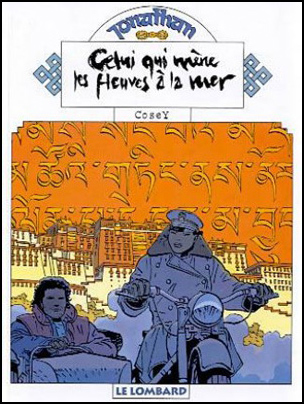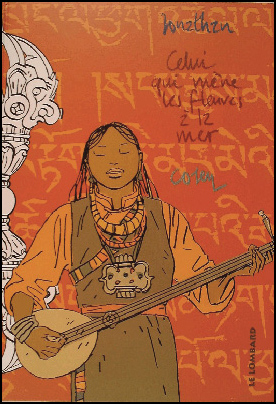
Hij die de rivieren naar de zee leidt/Der die Flüsse zum Meer geleitet Last page: 1997; album 1997

Cover of the special edition, large format.
Jonathan… eleven years later
After ‘Greyshore Island’ Cosey seemed to have stopped with the Jonathan series. Only eleven years later, a new album was published. A new Jonathan album after eleven years of silence. What were Cosey’s reasons to start again? ‘I have always told I would continue Jonathan as soon as it pleased me again. And this time, I was in the mood for it.’ ‘After the first nine albums, I felt I was running in cricles in my little Tibetan universe.’ But then, in 1994, 1995 and 1998, Cosey travels again to Tibet and parts of China. The first trip as a ‘tourist guide’, the two last ones in company with a friend photographer, Jean-Pierre Grandjean. ‘Well, after those journeys, I was recharged for making a new Jonathan.’ ‘This album in first instance was a project for ‘Aire Libre’. And then, the character of Jonathan imposed itself.’
Politics
In the first albums of Jonathan, Cosey writes about the political situation: the Chinese bombardment, the resistance by the Khambas. In later albums, politics play a less role. In this twelfth album, politics are more present than ever, not in the least because one of the main characters is a Chinese colonel, Lan. Cosey: ‘I don’t like messages, I don’t like political engagement in a comic or in a novel, because I – this is maybe a bit ambitious to say – but I think that a good book, a good movie, a good comic should position itself above the political message. But in the case of this album, it is true that after many journeys to Tibet and having taken home so many documents that do not comply with this mythological Tibet of which we have dreamt and that has existed, I felt almost obliged…’ ‘But anyhow, to draw scenes of torture (there are thousands of torture scenes to draw in Tibet at this moment, in the whole planet, the list in infinite), is not my cup of tea, I prefer to suggest it.’ Cosey about Tibet’s political position: ‘Tibet is the ‘water castle’ of Asia. All the great rivers have their sources there, which is of great value for the future. And furthermore, on the strategic position: there are fields of uranium, etc…’ ‘Tibet and China have been neighbors chronically at war, since always. The Chinese have invaded Tibet, and they have been hunted down by the Tibetans, who in their turn have invaded China and have gone as far as Beijing. Before being Buddhists, the Tibetans were a rather savage people. The Nepalese too have invaded Tibet.’ ‘But sure, Tibet has never been a province or a Chinese minority, it has always been an own entity. It has always been an independent country, occupied or not.’ ‘It was impossible not to testify about this.’
Documentation
Cosey: ‘This twelfth album is definitely much more rigorously documented then its predecessors. I begin to know these regions. The story is also enriched by my observations on the spot and situations I have experienced myself. And I think you can feel that in my drawings.’ ‘The Chinese colonel who sings in the Chinese army choirs [colonel Lan] really exists: I have met her in a Karaoke bar. She was one of the privileged of the regime, she was married to the chief of a grand hotel and she spoke English! And… she was beautiful…’
A complex read
Reading ‘Celui qui mène les fleuves à la mer’ requires an effort of the reader, it is not a very simple story. Cosey: ‘There are more difficulties. The flash backs, the fact that there are so many characters with Asian names.’ ‘However, this album is less experimental then ‘Zeke raconte des histoires’ or ‘Saigon – Hanoi’, so the effort that is required is less justified, one could have prevented it.’
Special products


Ex libris & silk-screen print of Lan.

Silk-screen print of Jonathan and the Potala Palace.
